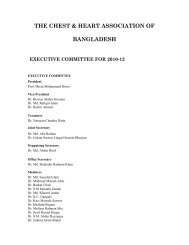Volume. 35, No. 2 july. 2011 - The Chest and Heart Association of ...
Volume. 35, No. 2 july. 2011 - The Chest and Heart Association of ...
Volume. 35, No. 2 july. 2011 - The Chest and Heart Association of ...
Create successful ePaper yourself
Turn your PDF publications into a flip-book with our unique Google optimized e-Paper software.
<strong>Chest</strong> & <strong>Heart</strong> Journal Vol. <strong>35</strong>, <strong>No</strong>.-2, July <strong>2011</strong>granulomatous pleuritis <strong>and</strong> 53 were nongranulomatous pleuritis. Among nongranulomatous cases 50 were due to malignancy<strong>and</strong> rest 3cases were due to nephritic syndrome,congestive cardiac failure <strong>and</strong> rheumatoid arthritisone in each.Table-IDistribution <strong>of</strong> age by sex <strong>of</strong> the respondentsAge (in year) Sex TotalMaleFemale70 07 (09.5) 02 (06.9) 09 (08.7)Total 74 (100.0) 29 (100.0) 103 (100.0)Mean ± SD 50.73 ± 19.27 49.00 ± 16.12 50.24 ± 18.38Table I shows the distribution <strong>of</strong> age by sex <strong>of</strong> therespondents. Mean ± SD <strong>of</strong> age <strong>of</strong> the patient was50.24 ± 18.38 years. Out <strong>of</strong> 103 patients with pleuraleffusion 74 were male <strong>and</strong> 29 were female. Male,Female ratio was 1.9: 1. Among the male highestnumber <strong>of</strong> patients were in the age group <strong>of</strong> 51 to60 years (29.1%) followed by 61 to 70 years (18.9%).Mean ± SD <strong>of</strong> age <strong>of</strong> male was 50.73 ± 19.27 years.Among the female highest number <strong>of</strong> patients werein the age group <strong>of</strong> 51 to 60 years (27.6%) followedby 41 to 50 years (24.1%) <strong>and</strong> 20 to 30 years (24.1%).Mean ± SD <strong>of</strong> age <strong>of</strong> female was 49.00 ± 16.12 years.Table IIDistribution <strong>of</strong> previous history <strong>of</strong> TBor contact with TBPrevious history <strong>of</strong> TB Frequency Percentor contact with TBPresent 05 04.8Absent 98 95.2Total 103 100.0Table II shows the distribution <strong>of</strong> previous history<strong>of</strong> TB or contact with TB. Most <strong>of</strong> the patients hadno history <strong>of</strong> TB or contact with TB (95.2%). Only5 (4.8%) had history <strong>of</strong> TB or contact with TB.Table-IIIDistribution <strong>of</strong> presenting complaints<strong>of</strong> the respondentsPresenting complaints Frequency * PercentFever 99 96.1Cough 98 95.1<strong>Chest</strong> pain 48 46.6Weight loss 43 41.7Dyspnoea 22 21.4Heamoptysis 09 08.7Loss <strong>of</strong> appetite 03 02.9Night sweats 03 02.9Others 02 01.9*Multiple responsesTable III shows the distribution <strong>of</strong> presentingcomplaints <strong>of</strong> the respondents. Common clinicalpresentations <strong>of</strong> patients were fever (96.1%), cough(95.1%), chest pain (45.6%) <strong>and</strong> weight loss (41.7%).Other clinical presentations were dyspnoea (21.4%),heamoptysis (8.7%), loss <strong>of</strong> appetite (2.9%) <strong>and</strong>night sweats (2.9%).Table-IVDistribution <strong>of</strong> pleural effusion in X-rayPleural effusion in X-ray Frequency PercentLocation• Right 78 75.7• Left 25 24.3<strong>Volume</strong>• Moderate 74 71.8• Large 07 06.8• Massive 17 16.5Table IV shows the distribution <strong>of</strong> pleural effusionin X-ray. Out <strong>of</strong> 103 cases <strong>of</strong> pleural effusion 78(75.7%) had right sided <strong>and</strong> 25 (24.3%) left sidedpleural effusion. Highest number <strong>of</strong> casespresented with moderate pleural effusion (71.8%)followed by massive pleural effusion (16.5%). Five(4.9%) presented with small pleural effusion <strong>and</strong> 7(6.8%) presented with large pleural effusion on X-ray findings.80



